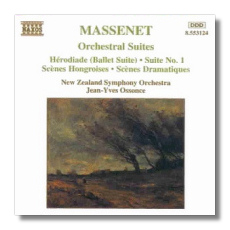
The Internet's Premier Classical Music Source
Related Links
- Massenet Reviews
- Latest Reviews
- More Reviews
-
By Composer
-
Collections
DVD & Blu-ray
Books
Concert Reviews
Articles/Interviews
Software
Audio
Search Amazon
Recommended Links
Site News
 CD Review
CD Review
Jules Massenet

Orchestral Suites
- Suite #1 Op. 13 (1865)
- Suite #2 "Scènes hongroises" (1871)
- Suite #3 "Scènes dramatiques" (1874)
- "Hérodiade" Ballet Suite (1881)
New Zealand Symphony Orchestra/Jean-Yves Ossonce
Naxos 8.553124
Jules Massenet is best known for his operas, especially Manon, Thais (with it's beloved 'Meditation' for violin and orchestra), and Werther. Nonetheless, he also produced a substantial body of orchestral music, including a Piano Concerto, Cello Fantaisie, and seven orchestral suites. Naxos has given us the first complete recording of the latter on a pair of budget-priced CDs. Keith Anderson's notes for the set are intelligent, informative, and almost brutally frank. In them he tells us quite honestly that "Massenet had sought success and found it. The price he paid for this is seen in his reputation for writing music that seems at times facile." That reputation is borne out by at least some of the music on this disc.
Hérodiade, completed in 1881, was among Massenet's earliest operas, predating his trio of masterpieces. It retells the grisly tale of a biblical love triangle: King Herod, Salome, and John the Baptist. The 'Divertissment' or 'Ballet Suite' derives from the final scene, wherein Herod entertains the Roman proconsul, Vitellius. It consists of five brief dances, each attempting to portray a different 'national' style. Thus we hear the sinuous oboes of the Egyptians, the militaristic pomp of the Babylonians, the stately procession of the Phoenicians, and so on. Not unexpectedly, it all comes out sounding far more French than Middle Eastern. The influence of Saint-Saëns's Samson and Delilah - premièred four years before the present work - is barely concealed beneath the flashy surface. Massenet repeats the bland themes of each dance mindlessly. The scoring, however, is brilliant and endlessly inventive.
Massenet's Suite 1 (1865) originally appeared as his Symphony in F. While it's much more musically sophisticated than the Hérodiade dances, its themes are not treated symphonically. Unlike the other six suites, this one does not bear a descriptive subtitle. The gorgeous opening of I (Pastorale) is based on a theme resembling the familiar Russian folk tune 'Slava' (also used by Beethoven, Moussorgsky, and many others). The melody rises slowly, tenderly from the depths of the strings. The fugue that concludes I calls to mind Stokowski's Bach, though Bach would not have repeated his theme as literally or obstinately. There isn't much variety in the Variations (II). Still there's a contemplative slower variation and a bold, dramatic conclusion. The Nocturne (III) is the Suite's weakest link. An enchanting theme is stated and, alas, restated ad nauseam. The composer does little more than mark time in the following trio. It's as if he intended to go back and fill in the melody at some later date, but somehow forgot to do so before the work was published. The finale consists of a sprightly march in the tradition of Berlioz, punctuated with plenty of brass and percussion. But in the end it's simply not as memorable as the beloved Rakoczy March, and it goes on far too long. The concluding stretto is a brief contrapuntal exercise that cleverly restates the pastoral theme of I.
Suite 2 ('Hungarian Scenes') dates from 1871. It is an orchestral arrangement of four-hand piano pieces that purport to portray a Hungarian wedding. In a letter Massenet told a friend that he did not value this work very highly. Despite the heavy, stamping rhythms of the opening dance, I detect none of the paprika of Bartók or Kodály. Nor is there a hint of the milder spices employed by Liszt and Brahms in their Hungarian works. The scoring is bright and brassy, with the orchestra cleverly employed to imitate church bells and, during the wedding procession itself, the church organ.
The most striking work on this disc is the Third Suite of 1874. Each of these three 'Dramatic Scenes' was inspired by a different Shakespeare play. The violent deluge at the beginning of I makes it clear that the play in question is The Tempest. Then Ariel and the other spirits who inhabit Prospero's island realm begin to play boisterously, accompanied by sounds that recall the fairy music of Mendelssohn's Midsummer Night's Dream. II was originally called 'The Dream of Desdemona', though in the end the composer dropped these descriptive subtitles. A radiant, richly romantic string interlude surrounds an agitated central section - no doubt foreshadowing Othello's jealous rage. The finale was inspired by Macbeth. It's a miniature suite within a suite that's divided into five sections, each depicting a different aspect of the play. The division into short segments allows the composer to avoid the repetition that plagues much of the other music here. The witches at the outset are appropriately diabolical, though the closing fanfares do sound rather more triumphal than one would expect at the end of such a dark tragedy. In any event, this work is vastly superior to the overblown and overlong 'Macbeth' of Richard Strauss. Massenet's score is inventive, powerful, and riveting - not to mention more faithful to the play than Herr Strauss.
The New Zealand Symphony is a polished and supple ensemble notable for its lovely, lush strings and mellifluous woodwinds. The solo oboe and clarinet deserve special mention for their sublime work. Ossonce is most sensitive to the slower music and the more passionate side of Massenet (his Desdemona is ravishing), but he needs a lighter touch and more fire in the allegros. Naxos' sound is resplendently clear, clean, and open. In short, this release is a nearly ideal introduction to some rarely heard and often quite astounding French orchestral music.
Copyright © 1997, Tom Godell


















